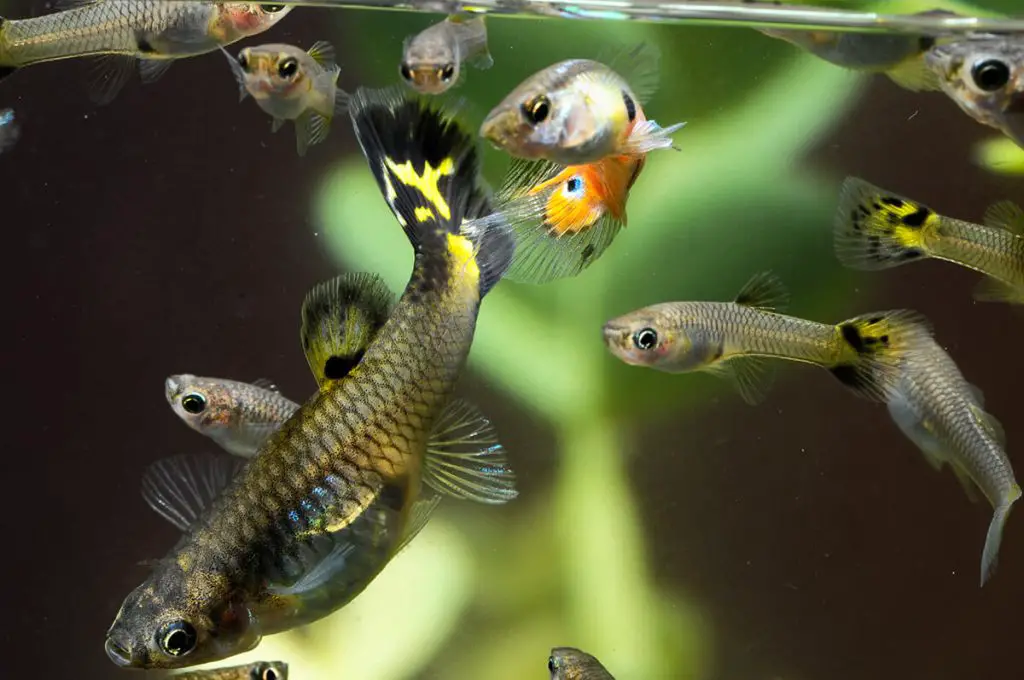Both for the sake of the fish and your wallet, start with only a few hardy inexpensive fish.
Damsels
The best beginner fish for a marine tank are damsels. These fish are very hardy, being able to withstand worse water conditions than most other marine fish, they are not picky eaters, and they are fairly inexpensive. The down-side is that they are fairly aggressive. One or two will co-exist in a tank. There will be a lot of fighting if you put more in. Dealers get away with a lot in their tanks by keeping the tanks so crowded that none of the fish can establish a territory. This is not acceptable for long periods of time. It is best to use damsels to break in a new tank. If you are then going to add other aggressive fish, you can keep the damsels. If you want to keep shy or delicate fish, you should take the damsels back to the pet store once you and your tank are ready for more fish.
Some damsels, such as the blue damsel and yellow tailed damsels, are not as aggressive as others, such as the three striped and domino damsels. In any case, damsels are certainly the best fish to start with.
Mollies
Some people like to break in a tank with mollies which have been acclimated to salt water. This gives you the benefit of starting with inexpensive fish and get used to maintaining salinity and pH on not-so-sensitive fish. Although safer, you don’t achieve much marine experience this way. Mollies are captive raised and bred.
If you buy mollies for your saltwater tank, you can acclimate them by dripping saltwater into the bag over a period of 6-8 hours, removing some water when the bag gets too full. Slowly increasing the salinity gives the mollies time to get used to their new environment. You can keep the mollies in the tank after it cycles, but any aggressive fish with continually harass the passive mollies.
Clownfish
Clownfish are related to damsels, and are fairly hardy. However, they are more difficult to acclimate to a new tank. Clowns, in general, are very territorial, but are not otherwise aggressive except to other clowns. They will do fine without an anemone, which is good since anemones are much more difficult to keep. Anemones require very clean water and high quality lighting. Also, each species of clown likes particular species of anemones, and none of them will regularly inhabit the inexpensive and easier to maintain Caribbean anemones. Some clowns are captive raised.
Blennies/Gobies
These small fish are somewhat hardy and are unlikely to cause trouble for the other fish in your tank. Some of them show a lot of personality, though they will get lost in a large tank. Many of these fish are excellent additions to a tank to help control algae. However, some feed by sifting through the substrate and will be very hard to keep fed in a fish-only tank (e.g., the mandarin fish).
Tangs (Surgeonfish)
Tangs are fairly hardy, though they are very susceptible to marine ich. Being algae eaters, they are useful to introduce when your tank starts growing algae. They must be fed leafy greens if there is no suitable algae growing in the tank (green algae). Many different tangs are commonly seen for reasonable prices.
Triggerfish/Lionfish
If you are setting up a tank for large aggressive fish, you can start with triggers and/or lionfish, as they are hardy. However, mistakes with them can be very costly, so you may want to practice on less expensive and easier fish. Also, carnivorous fish such as triggers and lions should be fed plenty of shell fish and other marine life. Specifically, many people feed lions feeder goldfish. This is really a bad practice because goldfish are freshwater fish and do not provide the same nutrition that a saltwater fish would. Specifically, feeding saltwater fish freshwater food can cause premature liver failure and the early demise of your fish.
Angels and Butterflies
These are fish that must be ignored while in the pet store – all are both delicate and difficult fish to keep. Many butterflies have specialized diets which make them hard to maintain in captivity.
Batfish are also other fish that should be avoided.
Others
Other saltwater fish which can be attempted once you get good at controlling the fish’s environment are hawk fishes, grammas, dotty backs, basslets, and wrasses. Some are more difficult to keep than others, but not nearly as difficult as angles and butterflies.
Fishes to Stay Away From
All angelfish, all butterfly fish, Pipefish, Seahorses, Long-nosed Filefish, Blue Ribbon Eels, Stonefish, and Moorish Idols. Mandarin fish should also be avoided in non-reef tanks (they are hard to feed).

